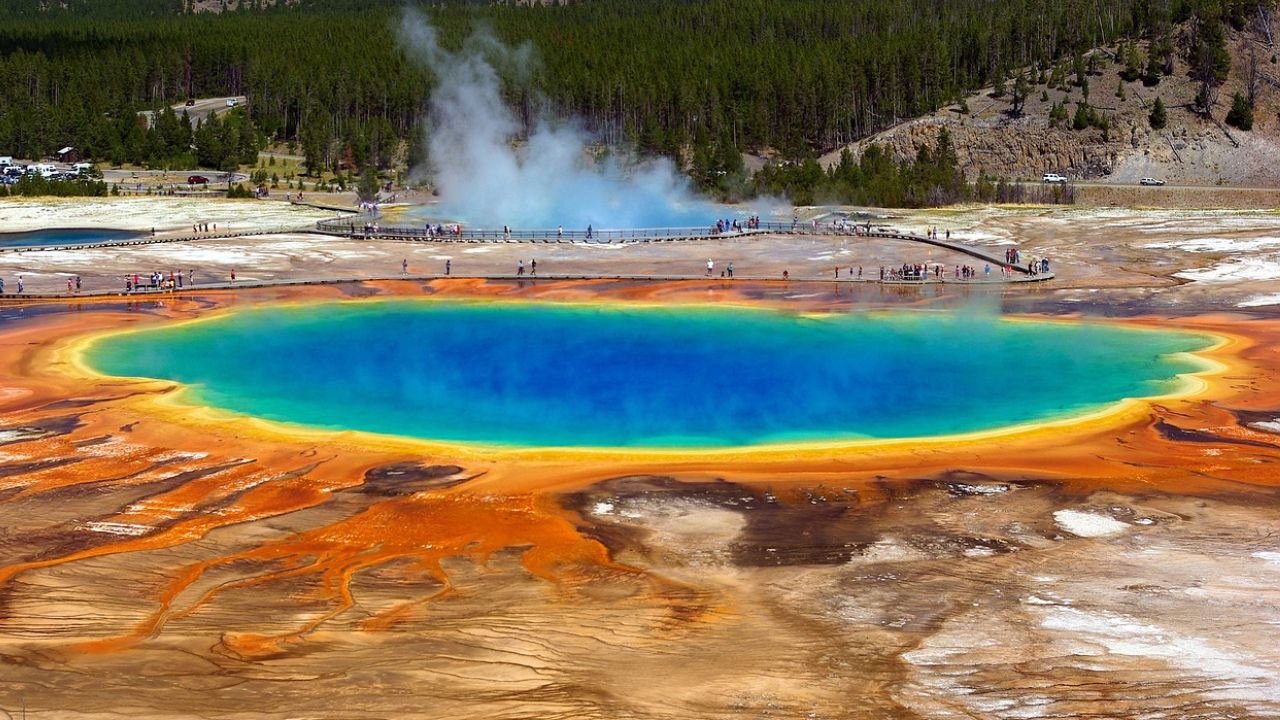Located in the heart of the Rocky Mountains, Wildlife in Yellowstone National Park stands as a testament to the raw beauty and untamed wilderness of the American landscape. Established in 1872, it holds the distinction of being the world’s first national park, attracting visitors from all over the world to marvel at its geothermal wonders, majestic landscapes and diverse array of wildlife. Among its many attractions, the most impressive experience for visitors is the park’s rich and diverse wildlife.
Spanning nearly 3,500 square miles of pristine wilderness, Yellowstone is home to an astonishing array of animal species, from the iconic bison and elusive wolf to the graceful elk and elusive grizzly bear. Every year, millions of visitors flock to the park hoping to catch a glimpse of these magnificent animals in their natural habitat, creating memories that last a lifetime.
Bison: Icons of the American West
No wildlife encounter in Yellowstone is as iconic as seeing a herd of bison roaming freely across the landscape. This majestic animal, often referred to as the buffalo, is the largest land mammal in North America and has long been synonymous with the American West. Yellowstone provides one of the last remaining strongholds for wild bison, giving visitors a rare opportunity to see these magnificent animals.
Always keep an eye out for these huge beasts when passing through the park, grazing in the meadows or crossing the road with their shaggy coats and distinctive humped shoulders. Although bison may seem tame, it is always important to remember that they are wild animals and should therefore be observed from a safe distance. Getting too close can be dangerous for both you and the animal, so always keep a respectful distance and use binoculars or a telephoto lens to admire them from a distance.
Wolves: Guardians of the Wilderness
A few wildlife encounters can be seen while walking through the forests of Yellowstone like a pack of wolves roaming around which can instill a sense of excitement and wonder in you. Once on the brink of extinction, these apex predators have made a remarkable comeback in recent decades thanks to conservation efforts within the park. Today, Yellowstone is home to several wolves, each playing an important role in maintaining the delicate balance of the ecosystem.
Although wolves are notoriously elusive and difficult to detect, visitors can hear their haunting howls echoing through the wilderness or catch a glimpse of their prey in the early morning or late evening, which is a warning signal. For the best chance of encountering wolves, consider joining a guided wildlife tour or participating in a ranger-led program where experts will help you look for signs of these elusive predators.
Elk: Masters of Adaptation
Another common sight in Yellowstone is its proboscis, also known as wapiti, which roam the park in large herds throughout the year. These majestic animals are highly adaptable and can be found in a variety of habitats, from grassy grasslands and forested valleys to inaccessible mountain slopes. During the fall season, male elk engage in fierce battles for dominance, belting out their distinctive calls and locking antlers in dramatic displays of strength.
Although elk are generally tolerant of human presence, it is important to maintain a safe distance, especially during the rut when bulls can become aggressive to protect their harems. If you encounter elk during your visit, observe them from a distance and avoid getting too close, especially if you hear anything like an excited hackle or vocalization.
Grizzly Bears: Symbols of the Wild
Arguably Yellowstone’s most iconic and sought-after wildlife is the grizzly bear, a symbol of the untamed wilderness and a powerful apex predator. Although encounters with these majestic animals are rare due to their solitary nature and vast home ranges, park visitors can glimpse grizzlies grazing along rivers and streams for food or traveling through alpine meadows in search of prey.
If you’re hoping to see a grizzly bear during your trip to Yellowstone, it’s important to take precautions beforehand and respect their space. Grizzlies are formidable predators and should never be approached or disturbed. Always keep a safe distance and be sure to follow park guidelines for bear protection, including carrying bear spray and making lots of noise when hiking in bear country.
Other Wildlife Encounters
In addition to bison, wolves, elk, and grizzly bears, Yellowstone is home to countless species of other wildlife, each playing a unique role in the park’s complex ecosystem. From elusive mountain lions and willy coyotes to agile bighorn sheep and flamboyant pronghorn antelope, Yellowstone’s diversity of wildlife never fails to impress.
As you explore the park, keep your eyes open for signs of animal activity such as tracks, scat and scratch marks on trees. Be respectful of wildlife habitat and avoid nesting birds, denning animals or feeding any wildlife you encounter. Remember that Yellowstone is first and foremost a protected natural area, and it’s up to all visitors to play their part in preserving its delicate balance for future generations to enjoy if you take care of it.
A visit to Yellowstone National Park is a visit to the epicenter of America’s wilderness, where every turn of the trail offers a chance to encounter exciting wildlife. Whether you’re mesmerized by bison grazing in a meadow, the haunting call of a wolf echoing through the forest, or the raw power of grizzly bears roaming the riverbanks, Yellowstone never fails to leave a lasting impression on those who venture into its wild embrace.
As you explore the park, be sure to tread lightly and take only photographs and memories with you as you leave without a trace. By respecting the park’s wildlife and natural beauty, we can ensure that Yellowstone remains a sanctuary for generations to come, where wildlife roams free and where adventure knows no bounds.

